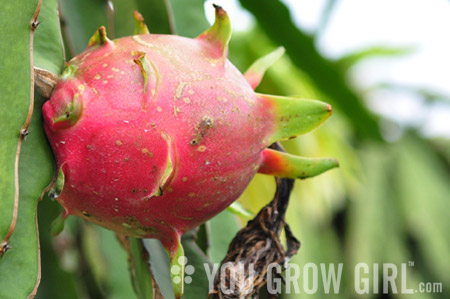
Pitaya, or dragon fruit, is a strange edible that is commonly sold (at a premium) in Asian food markets. The fruit is hot pink on the outside with an edible, white interior flesh that is dotted throughout with tiny, black seeds. The taste is mildly sweet, ever-so-slightly sour, and if I’m being honest, rather bland. Its saving grace are the crunchy seeds as they create a textured sensation that is fun to eat, not unlike a kiwi, but more exotic. I like it fresh and chilled, spooned straight out of that intense fuchsia skin.
The thing that intrigues me most about this fruit is the fact that it is grown on a cactus, and an epiphytic (air plant) one no-less. Hylocereus undatus is a night-blooming, jungle cactus that originated somewhere in the tropics of South America and the Caribbean, but is now most closely associated with South East Asia, where the fruit is grown commercially. Hylocereus is remarkably easy to grow as as houseplant and takes off equally well from seeds or cuttings. I know several gardeners that have successfully grown the seeds harvested from store bought fruit with no special effort or preparation. The plant requires more moisture and nutrition than a typical cactus, but can withstand periods of drought. It takes a tropical climate or a heated greenhouse to grow a plant large enough to produce fruit, but in the right conditions it can be made to produce in cramped quarters or a large pot.
There is a special place in my heart for epiphytic plants, so I was naturally excited about our trip to Thailand last year and the possibility of not just tasting a dragon fruit fresh off of the plant in its local environs, but actually seeing how they are grown for commercial production. As luck would have it, our trip did take us on a fruit farm tour to Suphattra Land in Rayong. Photos of that trip are attached and I will post more this week of some of the other fruit we saw there. I took several film shots as well, but as usual, I am buried in film and haven’t made it that far into the pile.
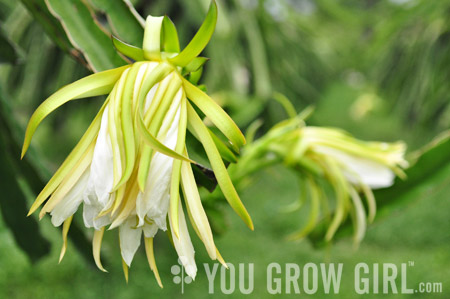
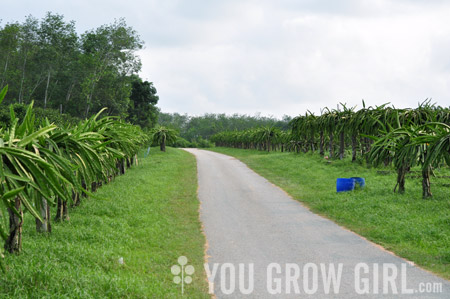
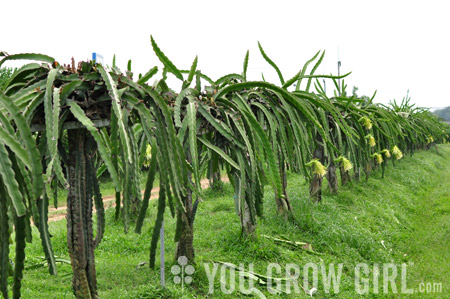


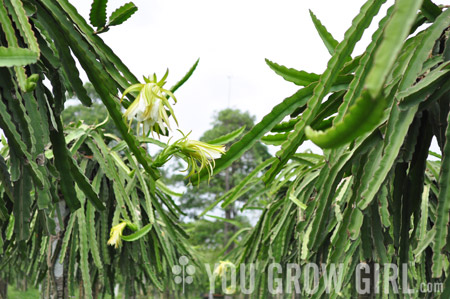
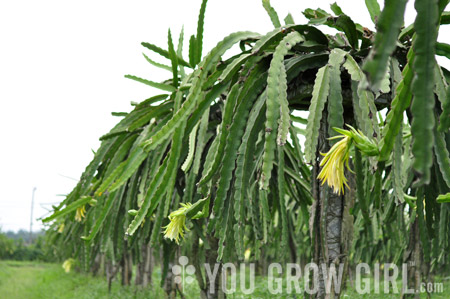
In case you’re wondering, I did eat dragon fruit while in Thailand. Our hotel in Chiang Mai served it sliced as a part of the breakfast buffet. Unlike most fresh tropical fruit, it didn’t taste any different than the overpriced fruit I bought at home in Toronto.
More fun facts about dragon fruit:
- Dragon fruit also go by the names, Pitahaya and strawberry pear, although it is unlike either fruit.
- They are used as the grafting stock for colourful cactus that do not produce their own chlorophyll.
- The flowers bloom at night and begin to shrivel by the following morning.
- The flower buds are also edible.
- There are other varieties, included a red-flesh fruit that is purported to be sweeter. Alas, I did not see any on my trip last spring, most likely because fall is their season.
Resources: The Cactus Family by Edward F. Anderson & Dokmai Garden’s Guide to Fruits and Vegetables in Southeast Asian Markets (bought in Thailand).
Note: Back in April 2011 I went on a 10 day, 3 city press tour of Thailand hosted by Thai Tourism. All of the posts I have written about this trip can be found here.
There are red and white varieties of dragon fruit and the white variety at room temperature is by far the nicest. Red dragon fruit is quite bland, commonly used in slices, added to drinks, but if you can get the white variety, very nice! Letting it warm up a bit to room temperature really lets the subtle flavours come out.
All I’ve had is the white variety. I prefer to eat it chilled. I’ve had it warm, but prefer the cool crispness.
Dragon Fruit is so pretty, but I agree with you, it is rather bland. I didn’t know about the red-fleshed variety. Will have to seek it out on some far-off future trip back to Southeast Asia!
Looking at Thailand photos makes me wish for a do-over. Although I really want to go to Vietnam.
I’ve heard that the yellow fleshed ones are the best. The white ones which rock up in the UK are not the tastiest fruits, but is this just a case of them being picked immature and chilled for shipping? This is sadly the fate of so many tropical fruits which never seem to develop a proper flavour as a result.
I had dragon fruit in Thailand and it wasn’t any better than the fruits I have bought here. Definitely not the case with other tropicals…
I bought some of the white fruit last year (at $4.99/lb) and made a dragonfruit blackberry jam with it. The seeds are indeed quite perfectly crunchy compared to other berries and such we are used to eating. I have to agree it was pretty bland in flavor and most posts I found said the pink fleshed inside fruits were sweeter. It gives you pause how something so bland can be so expensive and used in so many things…is it for flavor or for premium prices?
http://t.co/Gk4Go3y0 Pitaya, o dragón fruit, de plano que hay plantas raras :p
hmm i have to disagree with you, my roommate and i just tried dragon fruit a couple weeks ago, despite being from that region of the world myself. we had a red fleshed one and it was far from bland, if i wanted to be very critical about it, yes i would say it doesnt have as a unique and fully formed taste as something like a mango, but i still consider it mouth watering, somewhere between a papaya and a pomegranate.but i hate pomegranates, and apples, and oranges and bananas.. now starfruit…that’s a bland fruit.i am craving some dragon fruit now as i type.